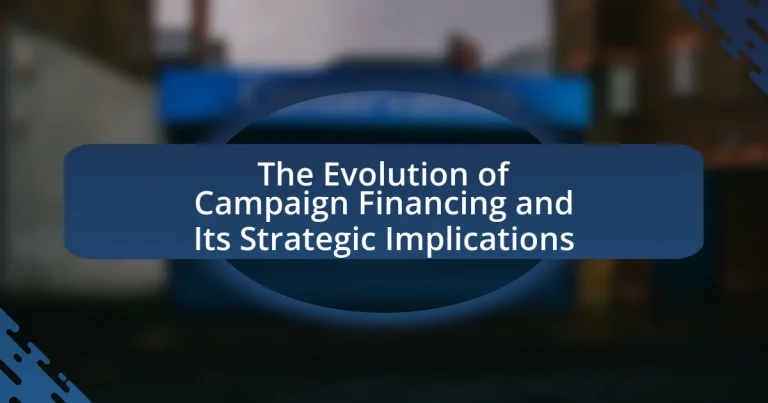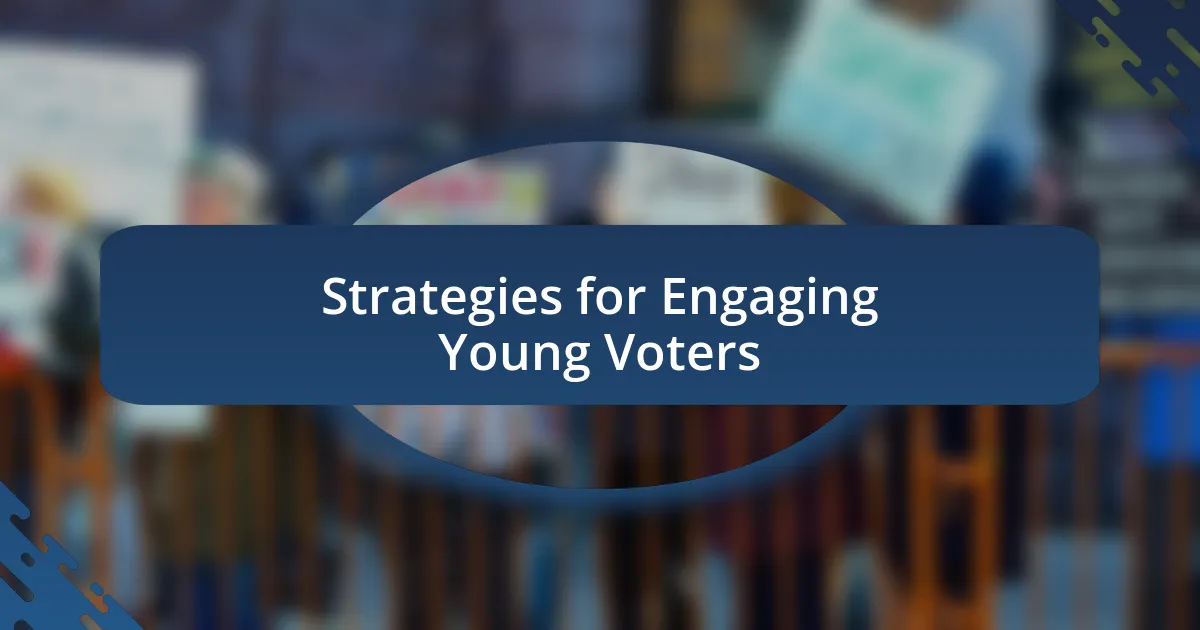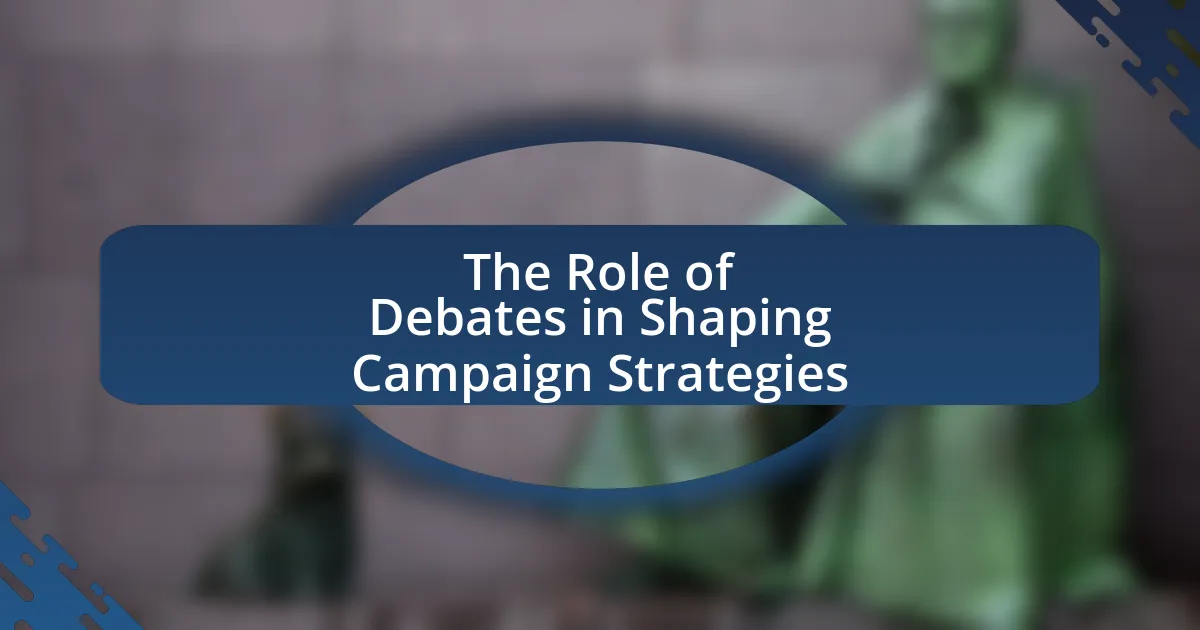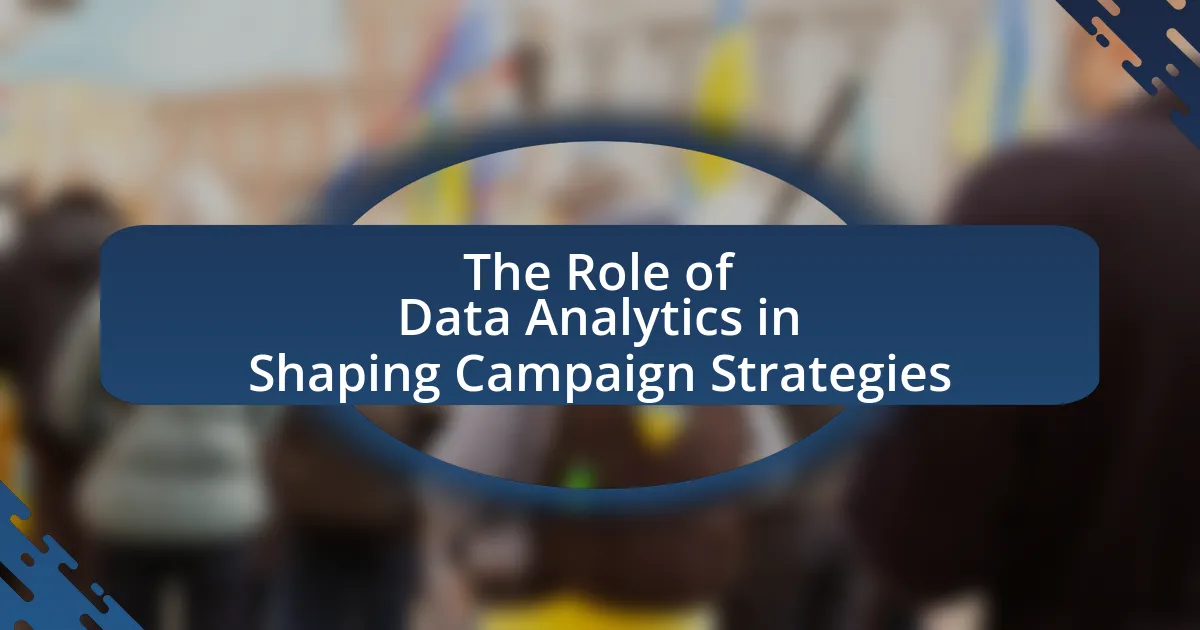The article examines the evolution of campaign financing, highlighting its transition from informal contributions to a complex system dominated by large donations from corporations and political action committees (PACs). It discusses key legislation, such as the Federal Election Campaign Act and the impact of the Citizens United v. FEC decision, which have shaped the regulatory landscape and increased the influence of money in politics. Additionally, the article explores how technological advancements and digital fundraising have transformed campaign financing strategies, the implications for democracy and voter engagement, and the ethical considerations surrounding PAC contributions. It concludes by outlining best practices for candidates to ensure transparency and diversify funding sources in a competitive electoral environment.
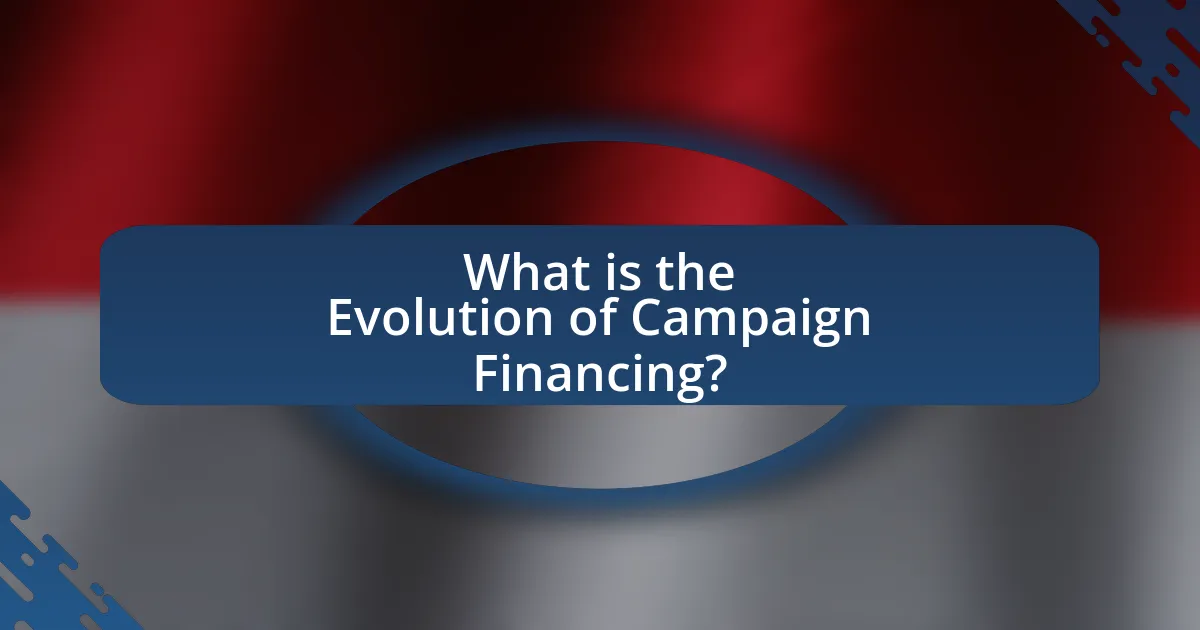
What is the Evolution of Campaign Financing?
The evolution of campaign financing has transitioned from informal contributions to a complex system involving large sums of money from various sources. Initially, political campaigns relied on small donations from local supporters, but the introduction of mass media and the rise of political parties in the late 19th century led to increased funding needs. The Federal Election Campaign Act of 1971 established regulations for campaign contributions and expenditures, marking a significant shift towards transparency and accountability. Subsequent amendments and court rulings, such as the Citizens United v. FEC decision in 2010, further transformed the landscape by allowing unlimited independent expenditures from corporations and unions, significantly increasing the influence of money in politics. This evolution reflects a growing interdependence between financial resources and electoral success, shaping strategic approaches to campaigning.
How has campaign financing changed over the decades?
Campaign financing has evolved significantly over the decades, transitioning from reliance on individual contributions and party funding to a complex system dominated by large donations from corporations and political action committees (PACs). In the early 20th century, campaign financing was largely unregulated, with candidates depending on small donations from local supporters. The introduction of the Federal Election Campaign Act in 1971 marked a pivotal change, imposing limits on contributions and requiring disclosure of campaign finances. However, the 2010 Supreme Court decision in Citizens United v. FEC further transformed the landscape by allowing unlimited independent expenditures from corporations and unions, leading to a surge in spending and the rise of Super PACs. This shift has resulted in campaigns becoming increasingly expensive, with the 2020 U.S. presidential election costing over $14 billion, reflecting the growing influence of money in politics and altering the strategic approaches candidates must take to secure funding and support.
What key legislation has influenced campaign financing?
Key legislation that has influenced campaign financing includes the Federal Election Campaign Act (FECA) of 1971, which established regulations on campaign contributions and expenditures. This act was amended in 1974 to introduce limits on individual contributions and to require disclosure of campaign finance information. Additionally, the Bipartisan Campaign Reform Act (BCRA) of 2002, also known as McCain-Feingold, aimed to regulate the financing of political campaigns by banning soft money contributions to national political parties and imposing stricter limits on individual contributions. These legislative measures have significantly shaped the landscape of campaign financing in the United States, impacting how candidates raise and spend money during elections.
How have technological advancements impacted campaign financing?
Technological advancements have significantly transformed campaign financing by enabling more efficient fundraising, targeted outreach, and data analytics. Digital platforms allow candidates to raise funds through online donations, which increased the total contributions to campaigns; for instance, the 2020 U.S. presidential election saw over $1 billion raised through online donations alone. Additionally, social media and data analytics tools empower campaigns to identify and engage specific voter demographics, optimizing resource allocation and messaging strategies. This shift has led to a more dynamic and responsive fundraising environment, where campaigns can adapt quickly to changing voter sentiments and fundraising opportunities.
Why is understanding the evolution of campaign financing important?
Understanding the evolution of campaign financing is important because it reveals how financial contributions shape political power and influence electoral outcomes. Historical changes in campaign financing laws, such as the Bipartisan Campaign Reform Act of 2002, demonstrate the impact of money on political competition and voter engagement. For instance, the rise of Super PACs following the Citizens United v. FEC decision in 2010 allowed unlimited spending by independent groups, significantly altering the landscape of campaign financing and increasing the influence of wealthy donors. This evolution highlights the necessity for ongoing analysis of financial regulations to ensure fair electoral processes and maintain democratic integrity.
What implications does campaign financing have on democracy?
Campaign financing significantly influences democracy by shaping electoral outcomes and policy decisions. High levels of financial contributions can lead to unequal representation, where candidates with substantial funding have greater visibility and influence, often overshadowing those with limited resources. For instance, a study by the Center for Responsive Politics found that candidates who spend more than their opponents typically win, highlighting the correlation between campaign spending and electoral success. Furthermore, the reliance on large donations can create a dependency on special interest groups, potentially compromising the integrity of democratic processes and leading to policies that favor donors over the general public. This dynamic raises concerns about the fairness and accessibility of the democratic system, as it may prioritize the interests of wealthy contributors over the needs of average citizens.
How does campaign financing affect voter engagement?
Campaign financing significantly affects voter engagement by influencing the visibility and reach of candidates. Increased funding allows candidates to invest in advertising, outreach programs, and grassroots mobilization efforts, which can enhance their presence in the community and attract more voters. For instance, a study by the Center for Responsive Politics found that candidates who spend more on campaigns tend to receive a higher percentage of votes, demonstrating a direct correlation between financial resources and voter turnout. Additionally, well-funded campaigns can utilize data analytics to target specific demographics, further increasing engagement among potential voters.

What are the Strategic Implications of Campaign Financing?
Campaign financing significantly influences electoral outcomes and political strategies. It determines the resources available for candidates, affecting their ability to communicate with voters, mobilize support, and compete effectively. For instance, candidates with substantial financial backing can afford extensive advertising, outreach efforts, and campaign infrastructure, which often correlates with higher chances of winning elections. Research indicates that in the 2020 U.S. elections, candidates who raised over $1 million were more likely to secure their party’s nomination and win their races, highlighting the critical role of financial resources in shaping electoral success. Additionally, campaign financing can lead to strategic alliances and endorsements, as candidates may seek financial support from influential donors or organizations, thereby aligning their policies with donor interests. This dynamic can impact legislative priorities and governance, as elected officials may feel beholden to their financial backers.
How do candidates leverage campaign financing for electoral success?
Candidates leverage campaign financing for electoral success by utilizing funds to enhance visibility, engage voters, and mobilize support. Financial resources allow candidates to invest in advertising, outreach programs, and events that increase their presence in the electorate. For instance, a study by the Center for Responsive Politics found that candidates who spend more than their opponents typically win their races, demonstrating a direct correlation between campaign spending and electoral outcomes. Additionally, effective fundraising strategies enable candidates to build strong networks of supporters and volunteers, further amplifying their campaign efforts.
What strategies do candidates use to attract funding?
Candidates use several strategies to attract funding, including building strong networks, leveraging social media, and hosting fundraising events. Strong networks allow candidates to connect with potential donors and influential supporters, which can lead to increased contributions. Social media platforms enable candidates to reach a broader audience, engage with supporters, and encourage small-dollar donations through targeted campaigns. Fundraising events, such as dinners or rallies, create opportunities for direct interaction with donors, fostering personal connections that can result in larger financial support. These strategies are supported by data indicating that candidates who actively engage in networking and utilize digital platforms tend to raise more funds compared to those who do not.
How does campaign financing influence campaign messaging?
Campaign financing significantly influences campaign messaging by determining the resources available for communication strategies. Candidates with substantial financial backing can afford extensive advertising, professional consultants, and targeted outreach, allowing them to craft more sophisticated and persuasive messages. For instance, a study by the Center for Responsive Politics found that candidates who raised over $1 million were able to spend significantly more on media buys, resulting in higher visibility and more refined messaging tailored to specific voter demographics. This financial advantage enables campaigns to shape narratives, respond to opponents effectively, and engage in issue framing that resonates with their target audience.
What role do Political Action Committees (PACs) play in campaign financing?
Political Action Committees (PACs) play a crucial role in campaign financing by collecting and distributing funds to support candidates, parties, or legislation that align with their interests. PACs enable individuals and organizations to pool resources, thereby amplifying their financial influence in elections. For instance, according to the Federal Election Commission, in the 2020 election cycle, PACs contributed over $1.5 billion to candidates, highlighting their significant impact on campaign funding. This financial support can help candidates amplify their messages, increase visibility, and enhance their chances of winning elections, thereby shaping the political landscape in favor of the PACs’ objectives.
How do PACs shape the political landscape through funding?
Political Action Committees (PACs) shape the political landscape through funding by providing financial support to candidates and parties that align with their interests, thereby influencing electoral outcomes and policy decisions. PACs aggregate contributions from individuals and organizations, allowing them to pool resources and amplify their impact on campaigns. For instance, in the 2020 election cycle, PACs contributed over $1.5 billion to candidates, significantly affecting the competitiveness of races and the priorities of elected officials. This funding enables PACs to promote specific agendas, sway public opinion, and ensure that their preferred candidates have the necessary resources to succeed, ultimately shaping legislative priorities and political discourse.
What are the ethical considerations surrounding PAC contributions?
Ethical considerations surrounding PAC contributions include potential conflicts of interest, the influence of money on political decisions, and the transparency of funding sources. PACs, or Political Action Committees, can contribute significant amounts of money to candidates, which raises concerns about whether elected officials prioritize the interests of their donors over their constituents. Research indicates that large contributions can lead to a disproportionate influence on policy-making, undermining democratic processes. Additionally, the lack of transparency in PAC funding can obscure the true sources of political influence, making it difficult for voters to hold elected officials accountable. These factors highlight the ethical dilemmas inherent in the relationship between money and politics.
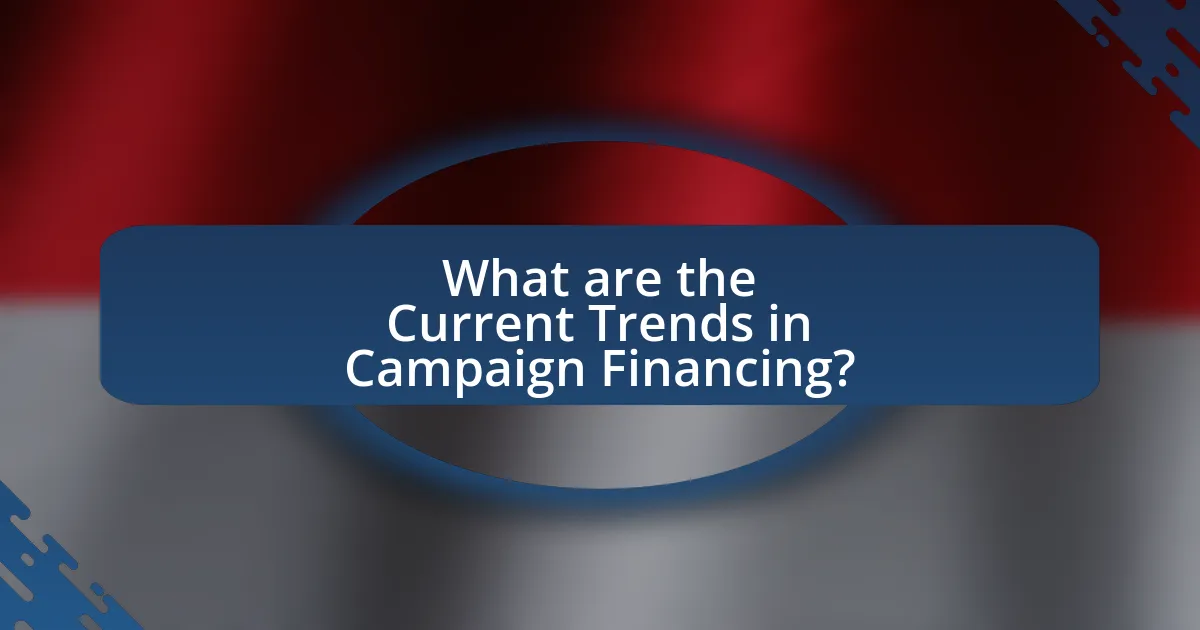
What are the Current Trends in Campaign Financing?
Current trends in campaign financing include the increasing influence of small-dollar donations, the rise of digital fundraising platforms, and the growing role of political action committees (PACs) and super PACs. Small-dollar donations have gained prominence, with candidates leveraging grassroots support to fund their campaigns; for instance, the 2020 U.S. presidential election saw a significant increase in contributions from individual donors, reflecting a shift towards more democratized funding sources. Digital fundraising platforms, such as ActBlue, have streamlined the donation process, enabling candidates to reach a broader audience and raise funds more efficiently. Additionally, PACs and super PACs continue to play a crucial role in campaign financing, with super PACs spending over $1 billion in the 2020 election cycle alone, highlighting their capacity to influence electoral outcomes through substantial financial contributions.
How has the rise of digital fundraising changed campaign financing?
The rise of digital fundraising has significantly transformed campaign financing by enabling candidates to reach a broader audience and raise funds more efficiently. Digital platforms allow for micro-donations, which have democratized contributions, making it easier for individuals to participate in political financing. For instance, in the 2020 U.S. presidential election, candidates like Bernie Sanders and Elizabeth Warren utilized online fundraising strategies that resulted in millions of small donations, showcasing the effectiveness of digital outreach. This shift has reduced reliance on large donors and traditional fundraising events, thereby increasing transparency and engagement in the political process.
What platforms are most effective for digital fundraising?
The most effective platforms for digital fundraising include GoFundMe, Kickstarter, and Indiegogo. GoFundMe is widely recognized for personal and charitable fundraising, having raised over $9 billion since its inception in 2010. Kickstarter is effective for creative projects, with over $5 billion pledged to various campaigns, showcasing its popularity among entrepreneurs. Indiegogo offers flexible funding options, allowing campaigners to keep funds even if they do not reach their goal, which has attracted a diverse range of projects. These platforms have proven successful due to their user-friendly interfaces, extensive reach, and established trust among users.
How do social media strategies enhance fundraising efforts?
Social media strategies enhance fundraising efforts by increasing outreach and engagement with potential donors. These platforms allow organizations to share compelling stories, updates, and calls to action, which can lead to higher donation rates. For instance, a study by the Pew Research Center found that 69% of adults in the U.S. use social media, providing a vast audience for fundraising campaigns. Additionally, social media facilitates real-time interaction, enabling organizations to respond to donor inquiries and foster community, which can strengthen donor relationships and encourage repeat contributions.
What challenges do candidates face in modern campaign financing?
Candidates face significant challenges in modern campaign financing, primarily due to the increasing influence of large donors and super PACs. This shift has led to a landscape where candidates often rely on substantial contributions from a small number of wealthy individuals or organizations, which can skew political priorities and limit grassroots support. According to the Center for Responsive Politics, in the 2020 election cycle, nearly 70% of campaign contributions came from just 0.1% of the population, highlighting the disparity in funding sources. Additionally, the complexity of campaign finance laws and regulations can create barriers for candidates, particularly those without extensive resources or political connections, making it difficult to navigate compliance while effectively raising funds.
How do regulations impact fundraising strategies?
Regulations significantly impact fundraising strategies by dictating the methods and limits of financial contributions. For instance, laws such as the Federal Election Campaign Act in the United States impose contribution limits and require transparency in reporting, which forces organizations to adapt their fundraising approaches to comply with these legal frameworks. Additionally, regulations can influence the timing and nature of fundraising activities; for example, restrictions on fundraising during certain periods, like election cycles, can lead organizations to strategize their campaigns around these legal constraints. This regulatory environment shapes how organizations prioritize donor outreach, allocate resources, and develop messaging to ensure compliance while maximizing fundraising potential.
What are the risks associated with reliance on large donors?
Reliance on large donors poses significant risks, including potential loss of autonomy and increased vulnerability to donor influence. When organizations depend heavily on a few wealthy contributors, they may prioritize the interests of those donors over broader stakeholder needs, leading to a misalignment of goals. This dynamic can result in compromised integrity, as seen in various political campaigns where donor agendas overshadow public interest. Additionally, over-reliance on large donations can create financial instability; if a major donor withdraws support, the organization may face severe funding shortfalls. Historical examples, such as the decline of certain political parties after losing key benefactors, illustrate the precarious nature of such dependence.
What best practices should candidates follow in campaign financing?
Candidates should adhere to transparency, compliance with legal regulations, and strategic budgeting in campaign financing. Transparency involves fully disclosing all contributions and expenditures to build trust with voters and stakeholders. Compliance with legal regulations, such as the Federal Election Commission guidelines in the United States, ensures that candidates avoid legal repercussions and maintain ethical standards. Strategic budgeting requires candidates to allocate resources effectively, prioritizing essential campaign activities that maximize voter outreach and engagement. For instance, a study by the Campaign Finance Institute found that campaigns that effectively manage their budgets can increase their chances of electoral success by up to 20%.
How can candidates ensure transparency in their fundraising efforts?
Candidates can ensure transparency in their fundraising efforts by publicly disclosing all contributions and expenditures. This includes providing detailed reports that outline the sources of funds, the amounts received, and how the funds are spent. For instance, the Federal Election Commission mandates that candidates file regular financial reports, which are accessible to the public, thereby promoting accountability. Additionally, utilizing online platforms for real-time reporting can enhance transparency, as seen in various successful campaigns that adopted such practices. By adhering to these standards, candidates can build trust with their constituents and demonstrate their commitment to ethical fundraising.
What strategies can candidates use to diversify their funding sources?
Candidates can diversify their funding sources by leveraging multiple channels such as grassroots fundraising, online crowdfunding platforms, and engaging with political action committees (PACs). Grassroots fundraising allows candidates to tap into small donations from a large number of supporters, which can build a strong community base and increase engagement. Online crowdfunding platforms, like GoFundMe or Kickstarter, enable candidates to reach a broader audience and attract contributions from individuals who may not be traditional donors. Additionally, forming alliances with PACs can provide substantial financial support, as these organizations often have established networks and resources to mobilize funds effectively. According to the Federal Election Commission, candidates who utilize a mix of these strategies can significantly enhance their financial stability and campaign reach.
